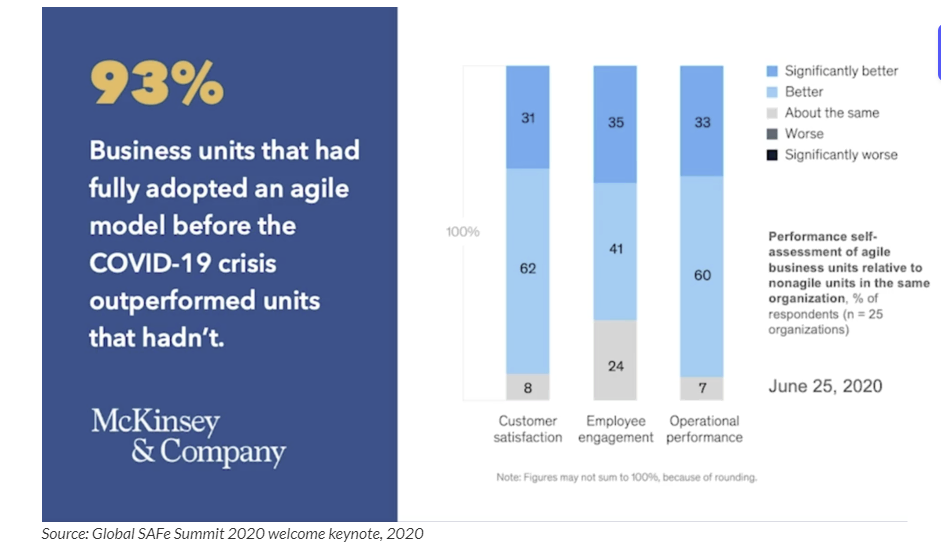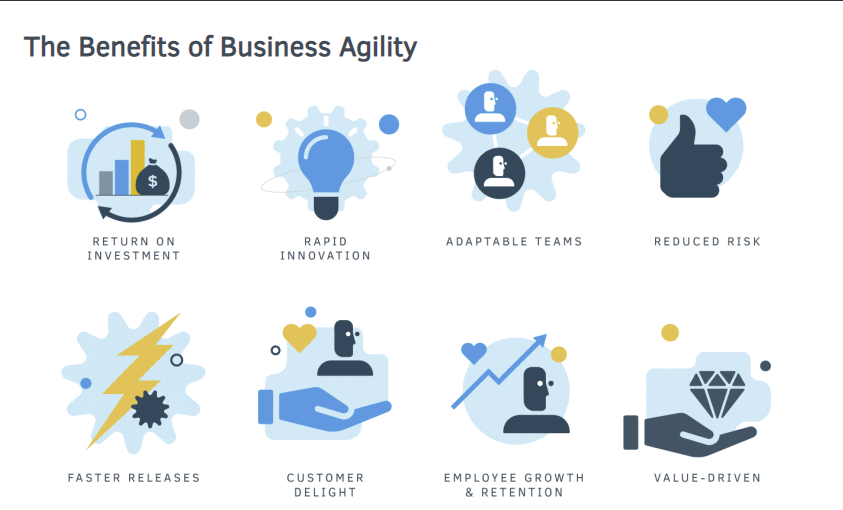Most IT and business professionals have heard the term "business agility" and understand its definition. However, in March of 2019, business agility became more than a concept. In the early days of the COVID-19 pandemic, business units had to change key practices, methodologies, and communication strategies literally overnight. And, they had to make existing technology work in new ways while simultaneously integrating virtual workspace technology into daily operations. Given this seismic impact, it's not surprising to learn that 93% of business units that had fully adopted an agile model before the current pandemic outperformed business units that hadn’t.

Source: (Apptio, 2020)
Today, business agility is again at the forefront as organizations navigate the rapid changes brought on by globalization, climate-change risk, and marketplace disruption due to artificial intelligence (AI) evolution. Invest in your business expertise and get ahead of the curve — learn more about business agility, agile principles and values, and how to adopt an agile culture in your organization.
Table of contents:
What is business agility?
In short, business agility refers to how quickly an organization is able to:
Proactively leverage information and technology resources to anticipate internal or external opportunities and obstacles (e.g., market research, real-time data, emerging technologies, employee and customer feedback).
Adapt quickly to abrupt changes in market or circumstance with new and unique solutions and a customer-centric approach.
Utilize rapid iteration to incorporate new information into product development at any point in its lifecycle.
Transform challenges into opportunities by focusing product management on customer value rather than organizational hierarchy and traditional business practices.
The benefits of business agility are significant. Not only does business agility help to fuel an organizational competitive advantage, but it also enables agile organizations to reduce product management risks, innovate more freely, release products and services faster, meet customer demands more fully, and even increase valuable employee engagement and retention.

(Source: ScrumAlliance, 2023)
However, in order for organizations to realize the benefits of business agility, it's necessary that they successfully internalize and implement the Business Agility Framework (BAF) and agile principles and values, and fully adopt an agile culture.
The Business Agility Framework (BAF)
When employed together, agile leadership, governance, and culture are able to drive organizational operations toward continuous improvement in response to competitive threats, workforce demands, and ever-changing customer and stakeholder expectations. These three concepts form the main principles of the Business Agility Framework (BAF) according to the Business Agility Consortium.
Leadership
While agile leadership has many of the hallmarks of "good business leadership," it requires more. Specifically, agile leaders must have the ability to employ true business agility in their own thinking prior to requiring it from their teams. This includes employing strategic agility when setting (or rapidly revising) overall team goals and functions while employing an agile mindset when considering how to best resource projects fulfilling strategic objectives. The ability to see uncertain outcomes as potential opportunities for growth and innovation is also an important way agile leaders embrace a business agility mindset.
In addition, to facilitate rapid iteration in their teams, agile leaders must be able to demonstrate this skill in their own activities as well. For example, the ability to receive team and customer feedback and adjust accordingly is a hallmark of an agile leader. Further, the ability to foster an agile business environment, where all team members feel empowered to share new ways of thinking about evolving customer requirements and internal and external opportunities, is critical in building an agile organization.
Governance
Agile governance, like agile leadership, contains many of the elements of good business practices. However, there are some additional elements that make a significant difference when attempting to achieve agility organizationally.
These key elements include:
Trusted autonomy: In agile organizations, empowering informed decision-making at the lowest responsible level is highly encouraged. This means that team members who may not be in traditional management positions are trusted to make informed decisions so the overall organization can remain responsive and at the pace that rapid iteration requires to deliver value. This can involve everything from re-evaluating customer needs to reassessing minimum viable product levels, or evaluating an emerging opportunity as it presents itself with real-time data.
Transparency: While many organizations talk about transparency, an agile company must embrace it every day as part of their internal and external approach to business. This means not only providing an auditable record of activities for compliance purposes but also making it easy for team members, stakeholders, and customers to see how key product and service initiatives are progressing and how they align with the overall mission and values of the organization as a whole.
Alignment: Everything an agile organization does should align with its overall purpose and values. And, while it could be said that this should be true of all organizations, it means something more to a company focusing on business agility. Specifically, it means that every business strategy must align back to agile principles and values, as well as the organization's mission and broader values. In a corresponding fashion, every project developed to carry out business strategies (e.g., everything from software development to human resources initiatives) within the entire organization must be in alignment.
Culture
To unlock business agility value, agile teams must be steeped in a culture that values agile methodologies, agile practices, and an agile mindset. For this to happen, the overall culture of the organization must include the following attributes:
Interdepartmental and interpersonal trust
Empowerment at all levels
True teamwork and collaboration
An iterative, adaptable development philosophy
A quality vs quantity attitude
Customer-centric KPIs
A continuous improvement focus
"Informed failure is a learning opportunity" mindset
Resiliency and creativity as valued traits
In addition, to become truly agile enterprises, organizations must fully embrace agile principles and values.
Adopting an agile culture
Based on the Agile Manifesto, a document created in 2001 by 17 programmers interested in developing software in new ways, there are four core agile values and 12 agile principles. Adopting an agile culture is critical to reaping the benefits of business agility. However, adopting an agile culture means more than just responding quickly to market changes or helping software teams create short development cycles. Rather, it requires putting customer needs first always, embracing agile culture attributes, and imbedding agile ways of working in every activity.
How to get started
Since immediate change across the entire organization is likely not a feasible option, it makes sense to begin with something that will a) positively impact revenue, b) mitigate risk, and c) be easily understood across various departments. The business agility value stream meets all of these criteria.
The business agility value stream is a thought process that enables organizations to evaluate potential opportunities quickly, taking advantage of the speed-to-market competitive advantage while still maintaining a focus on core agile values and principles.

(Source: ScaledAgile, 2023)
By proving the value of agile methodology via the business agility value stream, gaining support within the organization for the broader-based changes required to achieve enterprise agility via an agile culture is made more simple. In addition, by pointing to the value obtained by this small use case, justifying the cost of business agility training and business process adjustment can be quantified.
FAQs
What is business agility?
What are the three elements of the Business Agility Framework (BAF)?
Leadership
Governance
Culture